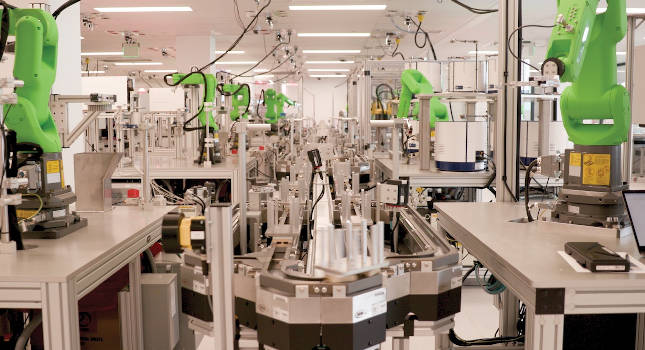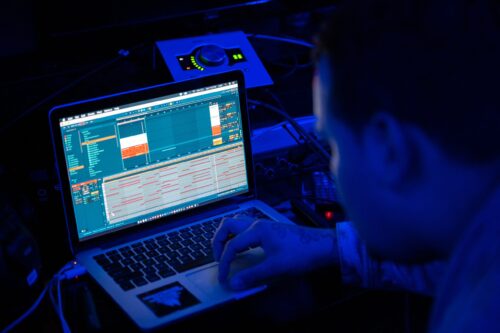IT/OT convergence combines industrial and laboratory automation
Teamwork enabled the creation of a large testing lab in just nine months
The COVID-19 pandemic inspired creativity and improvisation in many areas of industry. It also encouraged stronger collaborations, one of which created a high-capacity testing lab in an extremely short period of time. System integrator DMC helped Ginkgo Bioworks quickly create a sample-processing lab for diagnostic testing for COVID-19. The lab went from concept to bio-validation in nine months. Once the project was completed, the lab had the capacity to process 100,000 samples daily.
The new Ginkgo Bioworks lab, located in Boston, has more than 40 automated work cells, including robots, programmable logic controllers (PLCs), lab equipment and vision inspection systems (see Figure 1). Each work cell can be set up for new tasks, allowing Ginkgo to use it for other large-scale work in the future. The lab is automated, with samples making their way through conveyors and work cells with no human intervention.
DMC has offices in several cities in the U.S., including New York, Boston, Chicago, Houston, Dallas, Denver, St. Louis and Seattle. The engineering consulting firm focuses on software development and control systems in a variety of industries, including pharmaceutical, automotive, oil and gas, and food and beverage. Ginkgo Bioworks is based in Boston and is working to make biology easier to engineer on several fronts. This project leveraged the strengths of both companies. It was the first time Ginkgo had done automation at this scale, so it asked DMC to help.
“In a large, automated facility like this one, we’re blending a couple of different forms of automation,” said Henri Girard, automation engineer with Ginkgo Bioworks (see Figure 2). “We’re trying to blend industrial automation, where you see a lot of robots and PLCs, and lab automation from the world of biology. And, to make these two communicate together, we needed a smart SCADA platform that can bridge the gap between these two worlds.”
The supervisory control and data acquisition (SCADA) platform was crucial not only for that reason, but also because the requirements were constantly shifting as more was learned about COVID-19 in the early months of the pandemic. Given the demands on performance and the flexibility needed to keep up with the constantly changing requirements, DMC believed Ignition by Inductive Automation was a great fit for this project. It was also used for the human-machine interface (HMI) (see Figure 3).

Figure 1: The new Ginkgo Bioworks lab has more than 40 automated work cells, including robots, programmable logic controllers (PLCs), lab equipment and vision inspection systems. Courtesy: Inductive Automation
Up to the task
“The SCADA platform really shined in processing the massive volume of data and commands and tag changes that happen and flow through a system like this,” said Paul Mangels of DMC. “It was really good at managing that high volume of data that something this complex requires.”
The SCADA system also provided real-time dashboards for production data, reliable storage of event data and traceability data on all samples. Events occurred multiple times per second throughout the lab across the PLCs, and the SCADA system captured all the data. The lab instruments used a variety of different communication protocols, but the SCADA system tied things together with a consistent interface for users.
“We went from initial concept to final bio-validation of the laboratory in about nine months,” said Jay LaFave, project engineer for DMC. “We couldn’t have done that without all the capabilities of the Ignition software.”
“The pace of this project, I would say, is pretty unprecedented in the automation world,” Mangels said. “We had to move quickly because of COVID — and the knowledge we had was constantly changing, because the virus was changing and our science’s understanding of it was changing. The biological process we were trying to implement was evolving over the course of the project, so we needed a platform that would be flexible with us to stay up to date with those changes.”
The aggressive schedule required teamwork among the two companies, with strong convergence of SCADA and laboratory technologies. Numerous activities had to occur simultaneously. “The time scale was extremely accelerated by trying to do things in parallel,” Girard said. “We were trying to do some of the design, some of the software work and some of the hardware installation, all in parallel, as the process itself was also changing.”

Figure 2: Ginkgo Bioworks is blending different forms of industrial automation such as robots, PLCs and lab automation from the biology world. Courtesy: Inductive Automation
Concurrent development
“When we were creating this project, time was of the essence and so, we needed to grow the number of engineers we had working on the SCADA project,” LaFave said. “The software’s robust support for concurrent development allowed us to have 10 different developers working on the project at the same time — all while production and testing was ongoing. The ability to do that in a seamless way was critical to us achieving the timeline on this project.”
DMC also chose the software because of its flexibility since many requirements weren’t fully known at the start of the project. The SCADA system evolved along with everything else. “There are a lot of different components to the system,” Mangels said. “You have PLCs and device drivers talking to the lab equipment, various APIs from Ginkgo relating to inventory and moving parts through, and the SCADA system was right in the middle, helping to broker all that data and connect all the different parts of the lab together.”
Traceability was also an important requirement. “The process events are an auditable record of what happened to each sample as it moved through the lab,” Mangels said. “So, we used the SCADA system’s store-and-forward capabilities and transaction groups to quickly capture queues of events and log them in a structured query language (SQL) database.”
Capturing the huge volume of data was a challenge. “Each sample, as it went throughout the process, would produce upwards of 50 different unique data records,” LaFave said. “So, that equates to nearly half a million data rows per day, and the SCADA platform enabled us to capture all of that data in an effective and organized manner.”

Figure 3: Henri Girard is shown with HMI. Courtesy: Inductive Automation
Ready for the future
Both companies were pleased with the result. While a lot of it was uncharted territory, the collaboration was nonetheless successful, and it leaves Ginkgo with flexibility for future needs.
“A lot of biology relies on small-scale liquid handling between different plates, between different reagents and these operations can be very time-consuming to do at the bench for scientists,” Girard said. “On the other hand, once we can leverage the power of automation to multiply the throughput of all these operations by orders of magnitude, we can have a lot more shots at the goal, we can handle a lot more projects at the same time, and we can learn a lot more about the underlying biology as well.”
In addition to learning a lot along the way, engineers were also energized by the challenge. “This is probably the coolest project I’ve worked on in my time at DMC,” Mangels said. “We had a huge team of people. We worked with a whole bunch of organizations. The Ginkgo team was fantastic. Just the number of bright people that came into this project in different ways was amazing, and I definitely appreciated being a part of something and feeling like I was doing something to make a difference.”
Ginkgo Bioworks also appreciated the team effort. “DMC’s been great to work with,” Girard said. “They have really taken on all the challenges that we’ve given them during this project, despite the super-accelerated timeline and the constantly changing process. We were all learning as we were building the facility, really flying the plane while we were building it.”
Inductive Automation is a CFE Media content partner.
Do you have experience and expertise with the topics mentioned in this content? You should consider contributing to our CFE Media editorial team and getting the recognition you and your company deserve. Click here to start this process.






